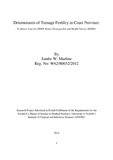| dc.description.abstract | Teenage fertility has been a major concern both nat
ionally and globally. A better understanding,
therefore, of its determinants to inform programmer
s, researchers and policy makers on how best
to reverse the trends so as to meet the Millennium
Development Goals (MDG) Number 1: To
eradicate extreme poverty and hunger; Number 2: To
achieve universal primary education;
Number 3: To promote gender equality and empower wo
men; Number 4: To reduce child
mortality and Number 5: To improve maternal health
will be useful. According to the Kenya
Demographic and Health Survey (KDHS) 2008-9, 18% of
young women age 15-19 had already
began childbearing. In Coast Province, 26% of teena
gers had either had a live birth or were
pregnant with their first child at the time of the
survey. This is the second highest national
teenage fertility after Nyanza Province (27%) with
the lowest being Central Province (10%).
As such, the objectives of this investigation is th
erefore to analyze the determinants of teenage
childbearing in Coast Province while examining the
socioeconomic, cultural, biological and
behavioral factors influencing teenage fertility in
this region.
247 respondents were eligible for this investigatio
n. Bongaarts Fertility Framework (1984) was
operationalized as it allows for identification of
major pathways through which socioeconomic,
cultural, biological and behavioral factors influen
ce fertility.
Multivariate logistic regression was used. Descript
ive statistics generated showed distribution of
women in the 15-19 age category by their background
characteristics. Cross-tabulations were
used to show any significant relationships that exi
st between each of the various predictor
variables on the outcome variable. To determine whe
ther these associations are statistically
significant, a Chi-square test was used to measure
the dependence of the association. The Chi-
square also showed if any two variables of cross ta
bulations were independent. Bivariate analysis indicated that there was statist
ically significant relationship between years of
schooling, religion, current marital status, age at
first sex and current use of modern
contraceptives. The risk of teenage childbearing va
ried quite significantly across the predictor
variables and none had a statistically significant
association with teenage fertility in the Coastal
Region.
As such, there is need to for further research to b
ring out the drivers of high teenage fertility in
Coast Province. A comparative study with Central Pr
ovince will be key as it is almost a third of
the teenage fertility in Coast. | en_US |
| dc.description.department | a
Department of Psychiatry, University of Nairobi, ; bDepartment of Mental Health, School of Medicine,
Moi University, Eldoret, Kenya | |

